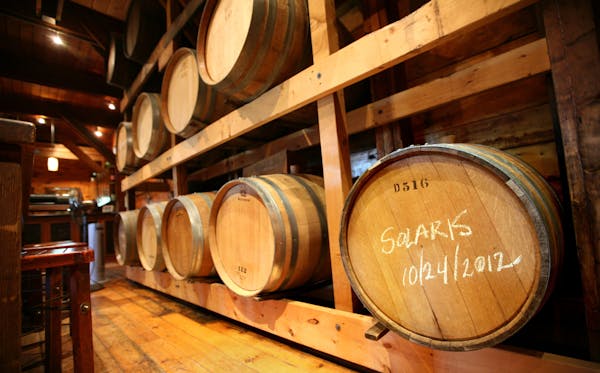There's yet another casualty of last winter's polar vortex: grapes.
About 30 percent of the state's wine-grape crop is missing in action, said Terri Savaryn, secretary of the Minnesota Grape Growers Association. Individual losses vary widely, from almost zero to 80 percent and up at some northern vineyards.
"Some are in very good shape, and others are taking it on the chin," said Peter Hemstad, University of Minnesota grape breeder and co-owner of St. Croix Vineyards in Stillwater. "It's not a catastrophe, but nobody's happy about it."
Kyle Peterson, winemaker at the family-owned Winehaven Winery in Chisago City, Minn., considers himself lucky to have lost only 10 percent of his winery's grapes. "We were really fortunate," he said. "Given what winter threw at us, we dodged that bullet."
Less fortunate was Carlos Creek Winery in Alexandria, which lost about 80 percent of its expected grape yield, according to co-owner Tami Bredeson. Most of the vines' roots survived, but the flower-producing died. That means they'll produce fewer grapes — or none at all.
The lowest temperature recorded last winter, minus-27 degrees, was "not extreme by Minnesota standards," Hemstad said. But the cold was unrelenting. "We had 50 days below zero."
"There was no January thaw," Bredeson said. "There was never a letup for the plants. They had to struggle so hard, for so long."
Because of the relative youth of Minnesota's wine industry, the plants also are young, which makes them more vulnerable to an extreme winter, according to Savaryn.
The state has nearly 50 bonded wineries, and most of them are young, she said. "There are few 20-year-old, established plants."
To supplement their own supply, growers who lost a lot of grapes are looking to other growing regions where yields are plentiful. "We're forced to source," Bredeson said.
Buying grapes from outstate growers won't increase the winery's costs, she said.
"We can purchase California grapes, and pay for shipping and still have it less expensive than Minnesota grapes," which require the same expensive equipment but are produced on a much maller scale than in major wine-growing regions.
While local wine production is likely to decrease in the short term, that doesn't mean Minnesota vintners can raise prices accordingly. "The problem we have is it's a worldwide market," said Hemstad.
"Argentina and Australia aren't going to be raising prices. People with Minnesota pride are willing to pay a premium over what they could get from Gallo, but only so much."
Wine connoisseurs who have developed a taste for Minnesota-grown wine likely won't notice any difference in taste, Bredeson said. "Making wine from Minnesota grapes is technically more difficult, and winemakers here have a lot of tools in their tool belt. They will be able to take the grapes purchased elsewhere and replicate the taste."
The impact could show up on wine labels, however. Instead of adding 10 percent of Cabernet grapes to a Marquette wine, a Minnesota vintner might have to switch to 70 percent Cabernet — and give the wine a fanciful name like "Winter Kill Red," Bredeson mused.
And with grapes in shorter supply, you might see more Minnesota wines made from other fruit, such as apples, berries and rhubarb. "We may experiment with black currants or aronia," said Bredeson. "This is the year to do that."
Kim Palmer • 612-673-4784
In heated western Minnesota GOP congressional primary, outsiders challenging incumbent

Minnesota Sports Hall of Fame: A class-by-class list of all members

This retired journalist changed professional wrestling from Mankato

